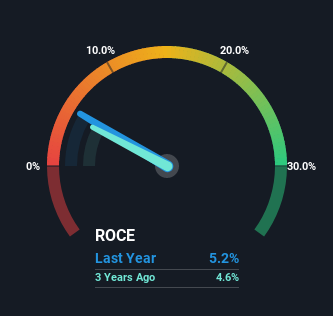- Sweden
- /
- Hospitality
- /
- OM:SHOT
Investors Could Be Concerned With Scandic Hotels Group's (STO:SHOT) Returns On Capital
Did you know there are some financial metrics that can provide clues of a potential multi-bagger? Typically, we'll want to notice a trend of growing return on capital employed (ROCE) and alongside that, an expanding base of capital employed. Basically this means that a company has profitable initiatives that it can continue to reinvest in, which is a trait of a compounding machine. Having said that, from a first glance at Scandic Hotels Group (STO:SHOT) we aren't jumping out of our chairs at how returns are trending, but let's have a deeper look.
Return On Capital Employed (ROCE): What Is It?
For those that aren't sure what ROCE is, it measures the amount of pre-tax profits a company can generate from the capital employed in its business. The formula for this calculation on Scandic Hotels Group is:
Return on Capital Employed = Earnings Before Interest and Tax (EBIT) ÷ (Total Assets - Current Liabilities)
0.052 = kr2.3b ÷ (kr51b - kr6.8b) (Based on the trailing twelve months to September 2022).
So, Scandic Hotels Group has an ROCE of 5.2%. In absolute terms, that's a low return and it also under-performs the Hospitality industry average of 14%.
See our latest analysis for Scandic Hotels Group

In the above chart we have measured Scandic Hotels Group's prior ROCE against its prior performance, but the future is arguably more important. If you'd like, you can check out the forecasts from the analysts covering Scandic Hotels Group here for free.
What Does the ROCE Trend For Scandic Hotels Group Tell Us?
In terms of Scandic Hotels Group's historical ROCE movements, the trend isn't fantastic. Around five years ago the returns on capital were 9.6%, but since then they've fallen to 5.2%. Although, given both revenue and the amount of assets employed in the business have increased, it could suggest the company is investing in growth, and the extra capital has led to a short-term reduction in ROCE. And if the increased capital generates additional returns, the business, and thus shareholders, will benefit in the long run.
What We Can Learn From Scandic Hotels Group's ROCE
In summary, despite lower returns in the short term, we're encouraged to see that Scandic Hotels Group is reinvesting for growth and has higher sales as a result. These growth trends haven't led to growth returns though, since the stock has fallen 37% over the last five years. So we think it'd be worthwhile to look further into this stock given the trends look encouraging.
One more thing to note, we've identified 1 warning sign with Scandic Hotels Group and understanding it should be part of your investment process.
While Scandic Hotels Group may not currently earn the highest returns, we've compiled a list of companies that currently earn more than 25% return on equity. Check out this free list here.
New: Manage All Your Stock Portfolios in One Place
We've created the ultimate portfolio companion for stock investors, and it's free.
• Connect an unlimited number of Portfolios and see your total in one currency
• Be alerted to new Warning Signs or Risks via email or mobile
• Track the Fair Value of your stocks
Have feedback on this article? Concerned about the content? Get in touch with us directly. Alternatively, email editorial-team (at) simplywallst.com.
This article by Simply Wall St is general in nature. We provide commentary based on historical data and analyst forecasts only using an unbiased methodology and our articles are not intended to be financial advice. It does not constitute a recommendation to buy or sell any stock, and does not take account of your objectives, or your financial situation. We aim to bring you long-term focused analysis driven by fundamental data. Note that our analysis may not factor in the latest price-sensitive company announcements or qualitative material. Simply Wall St has no position in any stocks mentioned.
About OM:SHOT
Scandic Hotels Group
Engages in the operation and franchising of hotels in Sweden, Norway, Finland, Denmark, Germany, and Poland.
High growth potential with solid track record.
Similar Companies
Market Insights
Community Narratives


Recently Updated Narratives


Alphabet: The Under-appreciated Compounder Hiding in Plain Sight


MINISO's fair value is projected at 26.69 with an anticipated PE ratio shift of 20x


The Quiet Giant That Became AI’s Power Grid
Popular Narratives


The company that turned a verb into a global necessity and basically runs the modern internet, digital ads, smartphones, maps, and AI.


MicroVision will explode future revenue by 380.37% with a vision towards success



